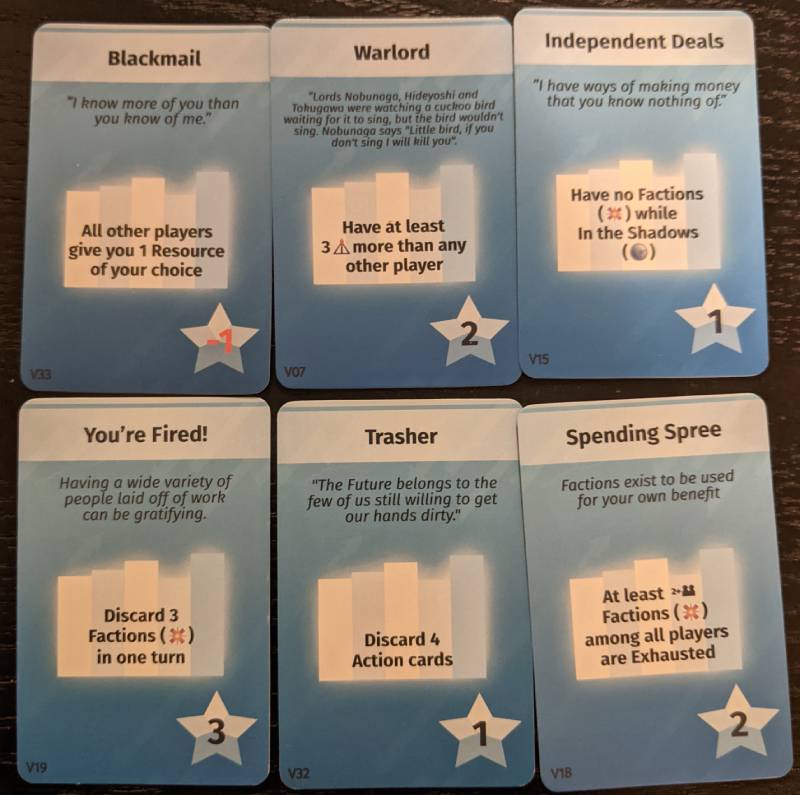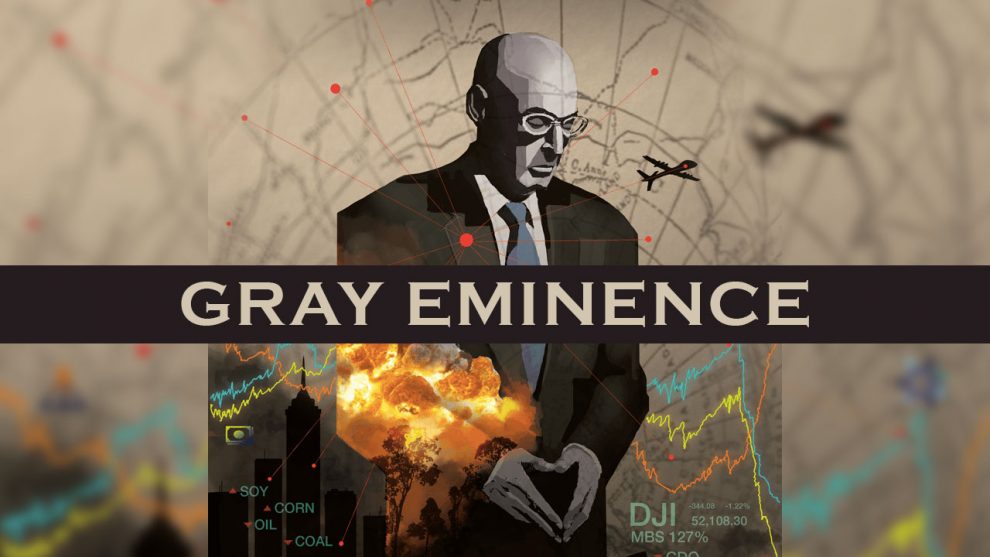Politically themed board games do not appeal to me much. This isn’t to say that there aren’t any good political games, as demonstrated by Bloc by Bloc. However, they tend to be pushed aside for yet another US political campaign game where you are trying to become President of the United States.
Also, call me pessimistic, but I don’t like politicians. There’s something about a rich person saying “vote for me so I have power over you” that raises a red flag for me. Moreover, voters tend to worship these politicians, giving off the same vibe as that weird guy who thinks the waitress really likes him.
Enter Grey Eminence.
Put on your hood and mask because today you will be one of these power masters pulling the strings. Perhaps you’ll be Deepthroat, who has a bit of influence, few friends, and wants to resolve issues focused on human rights. Alternatively, Queenie would provide you with the power of potent factions and you want to make sure the world doesn’t go off the deep end.

Dilemma of the day
Every round starts with a new Event card revealed, representing a new geopolitical problem. You might have to deal with the Italian elections, the Syrian Resolution, or EU limitations in China. To resolve these, you need to spend resources such as money, influence, or force.
Yet these events aren’t settled by one player. Players contribute resources to a “bidding pool” throughout the round, which is later used to resolve the event. It will have different effects depending on how it is resolved. Unresolved issues will be discarded and bad things will happen.
Interestingly, this is not how you gain victory points. Instead, you have public and private objectives to complete. You are driven by your character to achieve your public objectives, like Spaceman Jeff resolving certain Event types. Private objectives can range from paying off the Godfather to donating to science, and these objectives are hidden from other players.

Yanking the chain
In each round, the Event card is revealed and everyone is dealt a hand of green Action cards. These cards represent different political maneuvers and events, such as public donations or media manipulation. At their core, they are tools to manipulate the Bidding Pool, a way to gain resources, or a text effect that breaks the rules.
The Bidding Pool is a bit of an interesting mechanic because most of your spent resources will go there that will be used for resolving events. Resources can be spent on various actions, such as bidding for turn order, completing an objective, or executing an Action card.
There’s even a Tweet deck. Lovely.
Before you play your Action cards, you will draw cards from the Tweet deck, which shows a colorful tweet with its effects. There are some that exhaust certain factions but most of them are used to mess around with the bidding pool by removing or taking resources.

#99Problems
I’m already hearing the groans after reading those last few sentences, but hear me out. The way the message is conveyed here about the power of the American president is quite clever. The world will feel whatever the president tweets, says at a press conference, or the legislation he passes. Remember, you are a powerful figure behind the shadows whose sole concern is yourself. The United States is just as much a threat as your friends here.
Several cube movements later, it’s time to see if the Event card can be resolved by spending resources in the bidding pool. It must be done if there is only one possible way to resolve it. Multiple? Let’s talk. Players discuss which solution is best. This is where we witness backstabbing, broken promises, and pathetic attempts at negotiation. In the event there are insufficient resources for any outcome, then it remains unresolved, which leads to a negative effect on everyone. In fact, it is possible for everyone to lose the game if there are too many unresolved events.
Whatever the outcome, the next step is to trade. Cards and resources will be traded between players, and promises will be made. Even though this isn’t a new concept, Gray Eminence is probably one of the most open-ended trading systems I’ve ever encountered. Besides the Eminence card that represents you, everything else is tradable. Victory point tokens you earn during the game? Tradable. Objective cards? Tradable. Resources? Yep.
Scoring is the final step. A player can complete one, and only one, of his or her objectives per turn. Either the public objective associated with their character, or one of the secret objectives in their hand. Although it may seem odd to claim one objective at a time, I prefer this approach. It prevents a large point gap between players and keeps everyone emotionally invested in the game.
Disrespect the powerful
A lot of people abuse the word “theme” in board game reviews, and I admit that I do the same. Aesthetics and presentation are often mistaken for Theme when it is in fact the Setting. Theme is about the message the media is trying to convey. Gray Eminence is one of the few games that seamlessly ties its mechanisms and rules to its underlying message.
One simply has to look at the goal and flow of the game to clearly see what’s going on. You play a parody character mocking the numerous figures that control the throne behind the scenes. In order to accomplish this, you use money, influence, and power to resolve events that support your goals. These events impact lives internationally, such as the Venice Sinking, Climate Change Denial, or Sino-Latin American Pact. Are you trying to resolve them to better the world? Nope. It’s all about peacocking over your friends at the end of the day, because like your real-life counterparts, you are self-centered.
The objective cards proved to be a pivotal moment for me. Each Eminence character has its own set of objectives. Pick Green Greta and you want to solve ecology events and have the highest influence resources at the end of the game. Yet take a look at your hand of secret objectives, one of them says you want to be a Putinist and the other says you want to become a Warlord by having more power than everyone else. The narrative contradiction will be noted by one-half of your brain cells, while the other half is trying to figure out how to resolve it with little care about public perception. When you enter a state of thought like that, you can almost hear the trap closing.

Reflecting reality
Human beings aren’t the most reliable witnesses to their own ambitions and goals. Politicians and celebrities often say one thing but then act in an inconsistent way. A self-proclaimed communist will preach about worker’s rights while his family trust fund finances his living and he owns multiple million-dollar properties. A church that declares peace will siphon funds from its donors to fund anti-LGBT efforts or terrorist groups.
Gray Eminence allows you to create these dissonant narratives. You do not have to adhere to your public objectives if you do not want to and there is no “popularity” track. These people don’t care about you, and this game merely mimics their behavior. Jeff Bezos is unconcerned about you making another phallic rocket joke on your Twitter account. The man has enough money to give God a sex change. Twice.
I could go on about the thematic elements of the game, but I am going too far and I still need to talk about the game itself. In order to consume this product, you need to play it.
And this is where things go wrong.
Amateur mistakes
Looking through the rule book, I knew something was amiss. It introduces you to a list of rules associated with components without any context. When it describes phases, it omits critical information such as scoring. Although it simply states to score your cards, some of these objectives require you to compare resources with other players. But how is this done if other players’ resources are hidden? I had to go to their Discord to figure that one out, which I shouldn’t have to do.
The production issue should stop there, but it doesn’t. The beginner scenario of the game is the EU crisis, and the scenario is lost if at least half of the Events labeled with the #EU aren’t resolved. Easy, right? Except the EU hashtag is missing. On the back cover of the rulebook, it explains that doesn’t exist and to use the blue flowerbed instead. It states the reason they did this was due to printing space.
Printing space? Maybe try not using nearly four paragraphs of flavor text? I’m not kidding. There is flavor text for the Event itself, which is understandable, and then there are flavor texts for all four outcomes as well. There was no need for this. Furthermore, the font size for the cost and effect for each outcome is way too small. More space was dedicated to the flavor text than the actual gameplay. Why?
Even if the production was squeaky clean, the game itself is not as interesting as I hoped it would be.

Choiceless
When I read the game’s premise, I was under the assumption that the rules would take a backseat and the player interaction would carry this game like Atlas after chugging two scopes of his pre-workout. Instead, I had a bunch of systems thrown into a box and hoped for the best, as if it were designed in a boardroom where everyone spoke a different language.
One of the many problems is highlighted by the Trading phase. It sounds cool to be able to trade anything on the table. In practice, the economy is far too tight. Resources are too valuable to be traded since they are used for completing objectives, resolving events, and determining turn order. You are never in a position of surplus to make any reasonable trades.
In addition, the Actions and Tweet cards are extremely chaotic. No one in our group felt that their choices mattered during almost every session of Gray Eminence that we played. Several cubes can be thrown in only for them to be wiped out by an action card or two. This left no sense of control. As long as my decisions mattered, I don’t mind luck in my games. This, however, was too much.
Surprisingly, an expansion was released this year called The Year of Chaos, because 2020 happened. However, it doesn’t change the core of the game. There are simply more cards, which means more Tweets, Actions, Events, etc. There was one Tweet card that made me laugh. It was a Tweet card that banned the president from Tweeting, meaning no more random Tweet cards to mess up the situation for the rest of the game. Despite my many complaints about the game, the humor and the writing hit quite hard.
However, humor and writing aren’t what make the board game fun. There must be a cohesive set of rules, components, and strategies. I respect the message the game is trying to convey. I just wish that message was delivered by something better than a dilapidated truck with four bald tires and 3000 miles ‘til Graceland.











Add Comment